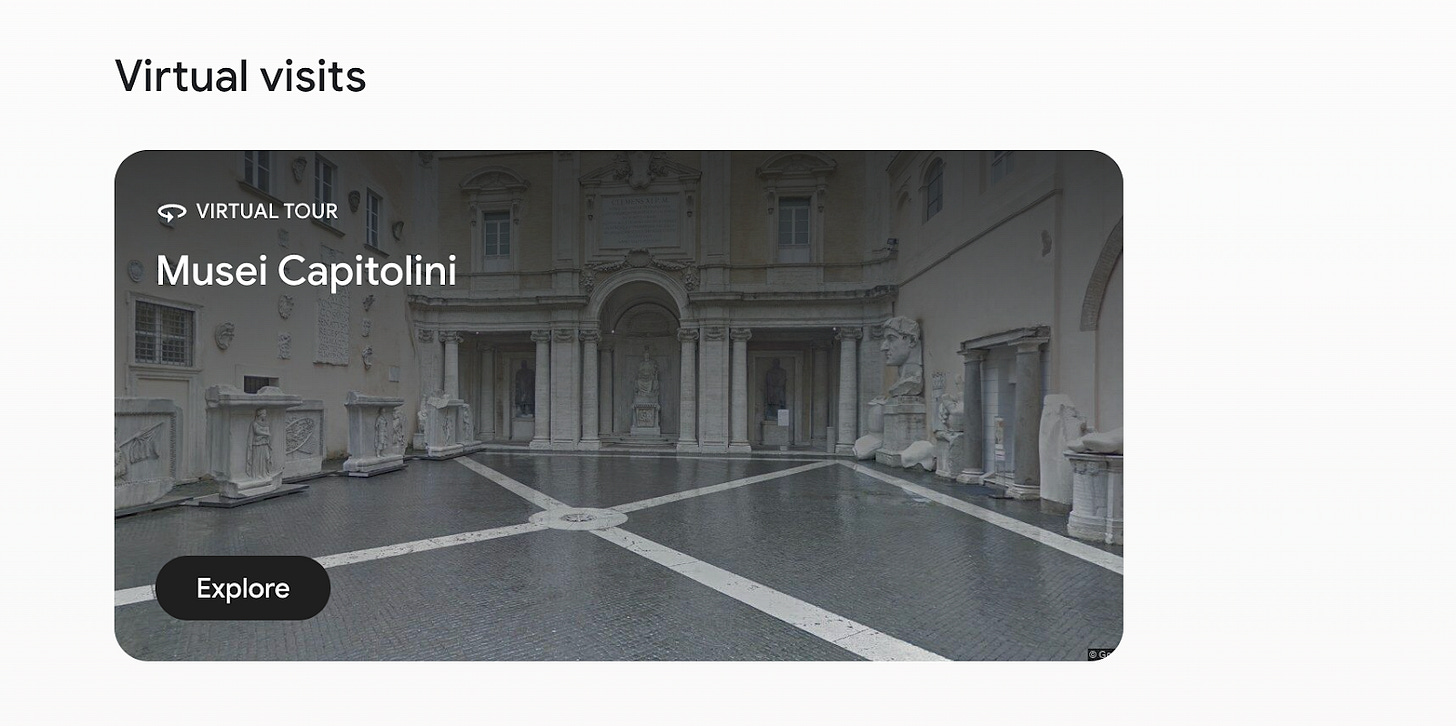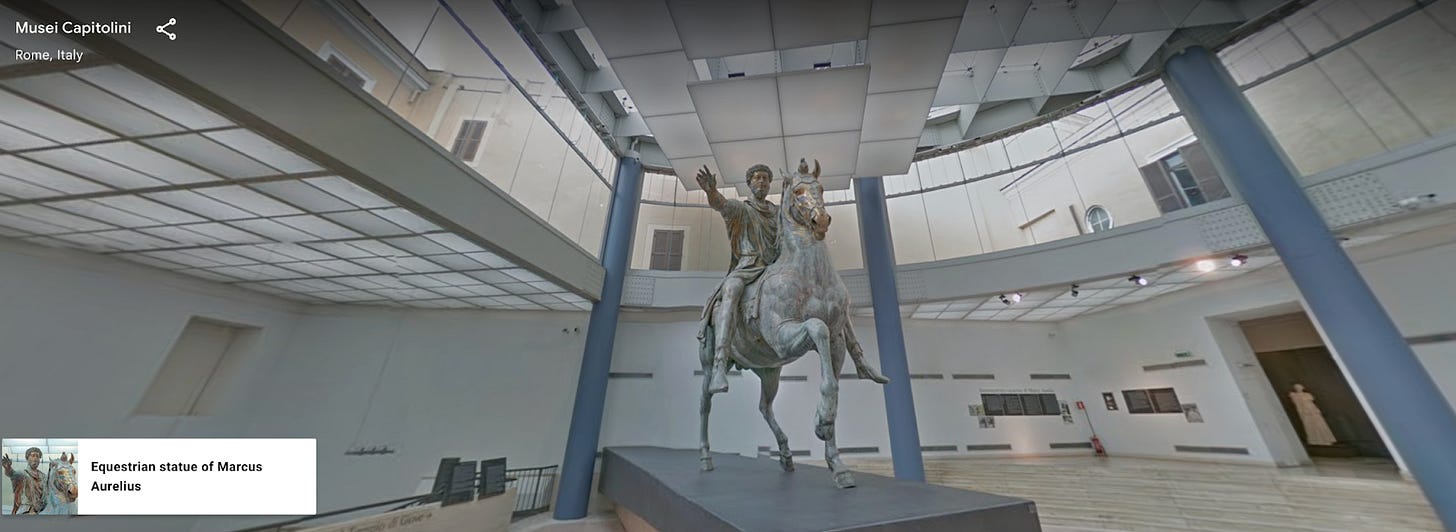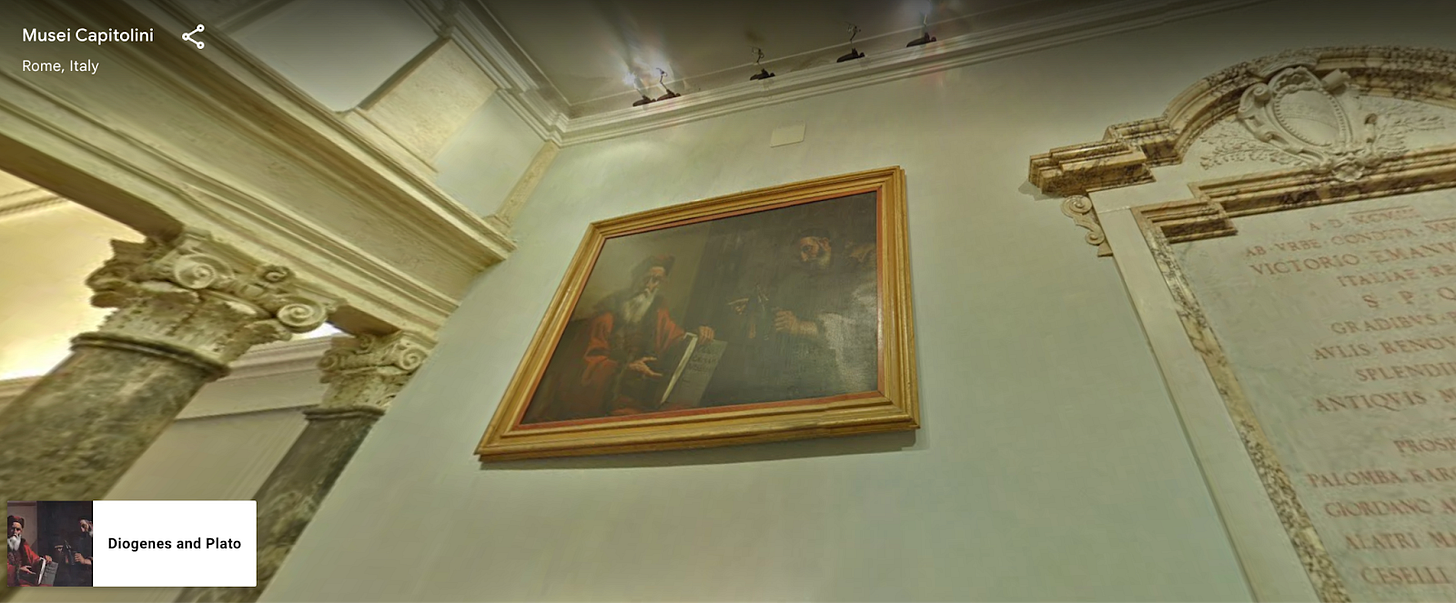Virtual Tour: Musei Capitolini in Roma, Italy
Constantine, Romulus & Remus and the Dying Gaul
Dear Classical KIDS,
For those who missed it, last Wednesday we had a ‘virtual tour’ of the Musei Capitolini in Roma, Italy. It was a blast! But as it’s a kids event, we can not record it... so I thought it would be fun to share my notes with you, in case any parent or teacher would like to recreate the event.
We used the arts and Culture segment on Google, so I have instructions, along with images below, so you can enjoy the tour. As you will see, I have written it out as ‘notes’, and of course you can add more or less details depending on the age and interest of the kids. There are plenty of more exciting rooms - but this activity took us about an hour all up, with lots of interaction from the kids.
I tried to include at least ONE GAME per room (in bold). These were a great success… Have a look and let me know which ones you enjoyed!
First, a little history about the museum itself. The Musei Capitolini dates back to 1471, when Pope Sixtus IV donated a group of bronze statues that until then had been kept at the Lateran. These are the core collection, but various popes subsequently expanded the collection with works taken from excavations around Rome. Lots of archaeological material was added at the end of the nineteenth century when Rome became the capital of Italy and new excavations were carried out.
Today it’s a fantastic museum with some of the most famous pieces from the ancient world….including the remains of the Colossus statue of Constantine, the famed symbol of Rome: Romulus and Remus suckling the she-wolf, Marcus Aurelius riding a horse, a painting of Diogenes and Plato, Spinario as well as the dramatic Dying Gaul - all of which we go into below.
Continue below to join us... virtually!
All the best,
Anya Leonard
Founder and Director
Classical Wisdom Kids
Virtual Tour: Musei Capitolini in Roma, Italy
By Anya Leonard
Introductions:
First, click onto the Arts and Culture Google Website for Musei Capitolini and navigate to “Virtual Tour”:
https://artsandculture.google.com/partner/musei-capitolini?hl=en
Hit Explore and join us in the first room to see the Colossus of Constantine:
Head of Constantine
Game: Scavenger hunt? Find the head, Foot, hand
Can you guess how big this statue is?
Judging by the size of the remaining pieces, the seated, enthroned figure would have been about 12 meters (40 feet) high. The head is about 21⁄2 meters tall and each foot is over 2 meters long. How many grown ups is that?
Who was Constantine?
a Roman emperor from AD 306 to 337 and the first Roman emperor to convert to Christianity.
Does anyone know the story of his conversion?
Maxentius' forces were still twice the size of Constantine's - Constantine shouldn’t have won!
Eusebius describes a vision that Constantine had while marching at midday in which "he saw with his own eyes the trophy of a cross of light in the heavens, above the sun, and bearing the inscription, In Hoc Signo Vinces ("In this sign thou shalt conquer")
When he won afterwards, he became Christian. NB: His mother was also Christian!
First Emperor to make Christianity legal. He changed the history of the Western world and brought Christianity into prominence.
Now... onto the next room (click the room option at the bottom) to check out: Romulus & Remus…
Romulus & Remus
A symbol of the city of Rome and the ancient Romans since at least the 3rd century BC.
Although the tale takes place before the founding of Rome around 750 BC...
Who were these little boys? What happened to them?
Romulus and Remus were born in Alba Longa, one of the many ancient Latin cities near the Seven hills of Rome. Their mother Rhea Silvia was a Vestal Virgin and the daughter of former king Numitor, who had been displaced by his brother Amulius. And their father was Mars (Do you know which god is Mars? What is his Greek equivalent?)
Seeing them as a possible threat to his rule, King Amulius ordered them to be killed and they were abandoned on the bank of the river Tiber to die. They were saved by the god Tiberinus, Father of the River and the twins were suckled by a she-wolf in a cave now known as the Lupercal. Eventually, they were adopted by Faustulus, a shepherd. They grew up tending flocks, unaware of their true identities. Over time, they became natural leaders and attracted a company of supporters from the community.
They joined forces with their grandfather and took back the throne and then debated on which hill to found the city.
So they used Augury - "taking the auspices". "Auspices" (Latin auspicium) means "looking at birds". They counted how many birds they saw. Romulus saw the most, but Remus said he won. They got in a fight and Romulus won and named the city of Rome after himself.
Game: Who can spot a bird now? Which type of bird would be a good Augur?
Game: What is True/False based on the story?
Romulus and Remus were born in Alba Longa
Their father was Poseidon
They were abandoned on the bank of the river Tiber to die, but saved by the god Tiberinus, Father of the River
The twins were suckled by a she-cow
Remus won the competition of counting the birds
Romulus named the city after himself
Now from the founding of Rome to one of Rome’s most famous Emperors, Marcus Aurelius! Click the next room to learn more:
Marcus Aurelius
Who knows who this guy is?
Roman Emperor - 26 April 121 – 17 March 180) was Roman emperor from 161 to 180 and a Stoic philosopher.
Famously wrote the Meditations, which was actually just his journal, but what published later on.
Does anyone know what Stoicism is?
An ancient Greek philosopher started by Zeno, who was a Phoenician. He had a bad shipwreck and lost everything, but learned about Philosophy when he came to Athens. He learned philosophy from a Cynic, but had ideas on how to improve it. He came up with Stoicism which is named after the Stoa where he and his students would talk.
While Stoicism started in Ancient Greece, it became very popular in ancient Rome, with Epictetus (who was Greek) and Marcus Aurelius, the Roman Emperor.
The philosophy teaches to live according to nature and to be virtuous.
Stoicism also reminds us that there are things are out of your control and things are in your control
Game: In or out. Shout out if these things are IN your control or OUT of your control:
Weather
How much Homework you get
How much work you put into your homework
Sitting in Traffic
What songs you play while sitting in traffic
Paying attention at school
What your parent cooks for dinner
How you respond when someone says a mean comment
Your attitude when you go over to a friends house
What country you were born in
What others think about you
Moving from the Romans back to the Greeks, from statues to paintings, we continue on to a story about Diogenes and Plato:
Diogenes and Plato
Plato vs Diogenes discuss what is a Man? This is a very funny story. But first, who are these two men?
Plato was a student of Socrates and founded the Academy in Athens. He believed in the existence of ideal forms and the importance of reason and knowledge.
Diogenes of Sinope, a leading figure of Cynicism, lived in a way that rejected societal norms and materialism, promoting a simple and self-sufficient lifestyle.
One day Plato was discussing what is a man in front of many of his students and he said that a man is a “Featherless bi-ped”. Diogenes thought (rightly?) that this was a bit silly. So he went and got a chicken which he plucked and returned to Plato and his students. He threw down the plucked chicken and responded, “Behold! Plato’s Man!”
It’s a fun reminder that the ancient philosophers didn’t always agree and that a man as brilliant as Plato wasn’t always right. While Diogenes is sometimes a little ‘out-there’, he does a good job of showing something as silly when it is silly.
Discussion: What do you think is a ‘man’? This is a hard one! It’s a question for the ages...
From a man to a boy...
Spinario
Boy with Thorn, also called Fedele (Fedelino) or Spinario, is a Greco-Roman Hellenistic bronze sculpture of a boy withdrawing a thorn from the sole of his foot, now in the Palazzo dei Conservatori, Rome.
The faithful messenger, a mere shepherd boy, had delivered his message to the Roman Senate first, only then stopping to remove a painful thorn from his foot: the Roman Senate commemorated the event.
Discussion: Why do you think they made a statue of this moment?
Discussion: The sculpture was one of the very few Roman bronzes that was never lost to sight. Why do you think that is? Which types of statues survived over time compared to others?
Last but not least, one of the greatest Hellenistic sculptures of all time: Dying Gaul
Dying Gaul
Do you know what a Gaul is? What is a celt?
Non Greeks were called Barbarians - but had very sophisticated cultures and art. The Greeks often thought it was strange they wore pants!
The warrior is represented with characteristic Celtic hairstyle and mustache with a Celtic torc around his neck.
An ancient Roman marble copy of a now lost Greek sculpture from the Hellenistic period (323–31 BC) thought to have been made in bronze
The original may have been commissioned at some time between 230 and 220 BC by Attalus I of Pergamon to celebrate his victory over the Galatians, the Celtic or Gaulish people of parts of Anatolia.
The statue serves both as a reminder of the Celts' defeat, thus demonstrating the might of the people who defeated them, AND a memorial to their bravery as worthy adversaries.
It is a very important piece in the world of Art: Famous for its pathos, part of the grand tour. It shows the Hellenistic style (the time period of Alexander the Great) which had a lot of movement and emotion. Thomas Jefferson wanted it/copy and Napoleon took it to Paris (but it was returned to Rome).
Game: Strike a Pose! Can you be one of the statues you see? Count 1,2,3 and copy one of the Statues.
Final Question: Which room/piece was your favorite? Why?










